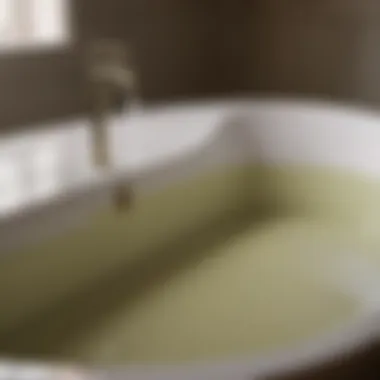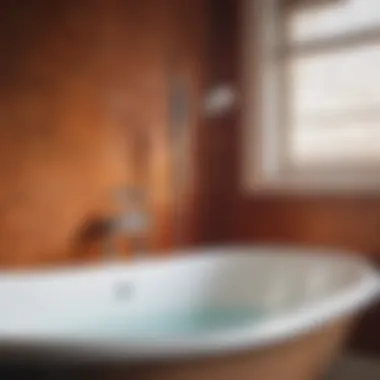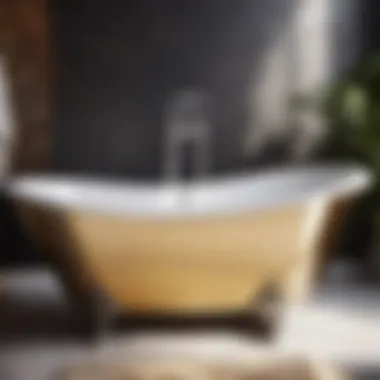Materials:
- Epoxy bathtub refinishing kit (ensure enough for a thick coating)
- Respirator mask for fumes protection
- Gloves for hand protection
- Sandpaper (grit sizes: 120, 240, 320)
- Cleaner and degreaser for surface preparation
- Caulk to fill any cracks or gaps
- Painter's tape to protect surrounding areas
- Brush or foam roller for application
DIY Steps:
-
Preparation: Start by cleaning the bathtub thoroughly with a degreaser to remove any dirt or grime. Sand the surface with 120-grit sandpaper to create a rough texture for better adhesion. Rinse and dry completely.
-
Repair: Check for any cracks or chips in the bathtub. Use caulk to fill in these imperfections. Allow it to dry completely before proceeding.
-
Masking: Protect the surrounding areas of the bathtub with painter's tape to prevent accidental staining or painting.
-
Application: Put on your respirator mask and gloves. Mix the epoxy components according to the kit instructions. Apply the first coat with a brush or foam roller, working from top to bottom in smooth, even strokes. Let it dry completely.
-
Second Coat: Sand the dried first coat lightly with 240-grit sandpaper. Apply the second coat following the same technique as the first. Allow it to cure as per the kit instructions.
Technical Aspects:
- Use the epoxy kit within the specified temperature range for best results
- Allow each coat to cure fully before proceeding to the next step
- Work in a well-ventilated area to avoid inhaling fumes
DIY Project Process:


- Follow each step meticulously for a professional-looking finish
- In case of drips or bubbles, gently sand them out between coats
- If the surface appears uneven, apply a third coat for a smoother finish
- For any excess epoxy on the tub edges, use a utility knife to trim it off carefully
Understanding Bathtub Refinishing


Understanding bathtub refinishing is a pivotal aspect of this comprehensive guide, which aims to empower individuals with the knowledge and skills needed to tackle this DIY project effectively. By delving deep into the intricacies of bathtub refinishing, readers can grasp the importance of proper preparation, application techniques, and safety precautions. A clear understanding of this process sets the foundation for a successful bathtub refinishing project, ensuring a professional finish without the need for external assistance.
Benefits of DIY Bathtub Refinishing
Cost-Effectiveness
Cost-effectiveness plays a crucial role in the realm of DIY bathtub refinishing. This subsection explores how opting for a DIY approach can lead to significant cost savings compared to hiring professional services. By detailing the specific cost-effective measures involved in the refinishing process, readers can make informed decisions regarding their budget allocation for this home improvement project.
Customization Options
Customization options open up a realm of creative possibilities for individuals embarking on a bathtub refinishing journey. This section highlights the flexibility and personalization opportunities that DIY refinishing offers, allowing homeowners to tailor the finish to their unique preferences and style. By exploring the various customization options available, readers can envision transforming their bathtub into a bespoke centerpiece of their bathroom.
Environmental Impact
Considering the environmental impact of bathtub refinishing is imperative in today's sustainability-conscious world. This segment sheds light on how DIY refinishing can be a more environmentally friendly choice compared to purchasing new fixtures. By elucidating the eco-friendly practices and products available for bathtub refinishing, readers can align their home improvement endeavors with environmentally responsible principles.
Types of Bathtubs Suitable for Refinishing
Fiberglass
Fiberglass tubs present a popular choice for refinishing due to their durability and versatility. This portion dives into the unique characteristics of fiberglass tubs, highlighting why they are well-suited for DIY refinishing projects. By outlining the advantages and potential drawbacks of refinishing fiberglass tubs, readers can determine if this option aligns with their renovation goals.
Porcelain
Porcelain tubs exude elegance and timeless appeal, making them an attractive candidate for refinishing projects. Here, we explore the inherent features of porcelain tubs that make them suitable for DIY refinishing. By discussing the pros and cons of refinishing porcelain tubs, readers can weigh the benefits of restoring these classic fixtures to their former glory.
Acrylic
Acrylic tubs offer a modern aesthetic and practical advantages that make them a favorable choice for homeowners seeking a sleek finish. This section elucidates why acrylic tubs can be successfully refinished through DIY techniques. By analyzing the unique properties of acrylic tubs and assessing the advantages and limitations of refinishing them independently, readers can confidently choose this material for their bathtub renovation.
Safety Precautions and Equipment
Ventilation
Creating a well-ventilated workspace is paramount when undertaking a bathtub refinishing project to ensure personal safety and proper product application. This segment elaborates on the significance of adequate ventilation and how it contributes to a successful refinishing endeavor. By understanding the role of ventilation in minimizing health risks and optimizing the curing process, readers can implement the necessary measures for a safe and effective project.
Protective Gear
Prioritizing the use of protective gear safeguards individuals from potential hazards associated with refinishing chemicals and tools. Here, we emphasize the essential protective gear required for a DIY tub refinishing project. By outlining the types of protective equipment, their functions, and the benefits they offer in terms of personal safety, readers can prioritize their well-being throughout the refinishing process.
Tools Required
Equipping oneself with the right tools is fundamental to executing a successful bathtub refinishing project. This section details the specific tools necessary for each stage of the refinishing process, from preparation to application. By outlining the functions of essential tools, their utility in achieving a professional finish, and potential alternatives or accessories to consider, readers can approach their DIY project with efficiency and confidence.
Preparation Steps


Preparing your bathtub before refinishing is a crucial step that sets the foundation for a successful DIY project. Each element of the preparation process plays a key role in ensuring a professional finish and extending the longevity of the refinished surface. By meticulously following the preparation steps outlined in this article, you can achieve outstanding results that rival those of professional refinishing services.
Cleaning and Degreasing the Bathtub
Choosing the Right Cleaning Agents
Selecting the appropriate cleaning agents is paramount in preparing your bathtub for refinishing. The choice of cleaning agents should consider the material of your bathtub and the level of dirt and grime present on the surface. Opt for non-abrasive cleaners that are gentle yet effective in removing soap scum, mineral deposits, and other residues without damaging the bathtub's finish. Biodegradable and environmentally friendly cleaning agents are recommended for a green approach to refinishing. These agents offer the dual advantage of being safe for the user and eco-friendly, aligning with the DIY ethos of this article.
Removing Old Caulk and Grime
Before applying any new coatings, it's essential to eliminate old caulk and grime buildup from the bathtub surface. Old caulk can interfere with the adhesion of the refinishing materials, leading to poor results. Thoroughly removing old caulk and grime ensures a clean canvas for the subsequent steps in the refinishing process. Utilize caulk removal tools and gentle abrasives to carefully eliminate all remnants of previous sealants and dirt. This thorough cleaning paves the way for a seamless refinishing experience and enhances the overall aesthetic appeal of the bathtub.
Surface Sanding
Surface sanding is a critical step in promoting adhesion between the refinishing coatings and the bathtub surface. By lightly sanding the bathtub's surface, you create a textured foundation that allows the new coatings to bond effectively, reducing the risk of peeling or chipping over time. The sanding process smoothens out imperfections, scratches, and uneven areas, preparing the surface for a flawless finish. Choose fine-grit sandpaper to delicately sand the bathtub, ensuring uniformity across the entire surface. Moreover, thorough sanding enhances the durability of the refinishing coatings, contributing to a long-lasting and professional-looking result.
Repairing Chips and Cracks
Addressing chips and cracks in your bathtub is paramount to achieving a smooth, uniform surface during the refinishing process. Repairs should be conducted meticulously to ensure a flawless final appearance. This section delves into specific aspects of repairing chips and cracks, guiding you through essential techniques for a successful DIY refinishing project.
Epoxy Putty Application
Epoxy putty application is a versatile and durable method for repairing minor to moderate chips and cracks in bathtubs. This approach involves mixing epoxy resin with a hardening agent to create a pliable compound that can be molded and shaped to fill in damaged areas. Epoxy putty adheres well to various bathtub materials, ensuring a secure and long-lasting repair. Its waterproof properties make it an ideal choice for wet environments like bathtubs. By meticulously applying and shaping the epoxy putty, you can seamlessly mend imperfections and restore the bathtub's integrity.
Sanding Down Rough Areas
After filling in chips and cracks with epoxy putty, sanding down rough areas is essential to achieve a level surface. Sanding the repaired areas smoothens out any excess putty, blends it seamlessly with the surrounding surface, and prepares it for the subsequent refinishing coats. Use fine-grit sandpaper to gently sand the repaired sections, ensuring a flush finish that seamlessly integrates with the rest of the bathtub. This meticulous approach guarantees a uniform surface free of imperfections, enhancing the overall aesthetic appeal of the refinished bathtub.
Ensuring a Smooth Surface
Once all repairs have been made and rough areas have been sanded down, ensuring a smooth surface is crucial for the success of the refinishing project. Run your hand across the entire bathtub surface to detect any remaining rough patches or inconsistencies. Address any lingering imperfections by lightly sanding those areas until the surface is uniform and smooth to the touch. A flawlessly smooth surface sets the stage for impeccable adhesion and a professional-grade finish that will stand the test of time.
Masking and Protecting Surrounding Areas
Prior to applying refinishing coatings, it's imperative to mask and protect surrounding areas to prevent accidental damage or overspray. This section delves into the specifics of taping off fixtures, covering floors and walls, and securing ventilation to safeguard your bathroom during the refinishing process. By implementing these protective measures, you ensure a tidy workspace and safeguard adjacent surfaces from unintended refinishing effects.
Taping Off Fixtures
Taping off fixtures such as faucets, handles, and drains is essential to prevent them from being coated during the refinishing process. Masking these components ensures that only the bathtub surface receives the refinishing treatment, maintaining the functionality and aesthetic appeal of the fixtures. Use high-quality painter's tape to secure protective coverings around fixtures, ensuring a precise border between the bathtub and the fixtures. This meticulous approach guarantees a seamless refinishing process without compromising the functionality of your bathroom accessories.
Covering Floors and Walls
Covering floors and walls surrounding the bathtub is essential to protect these areas from potential overspray or spills during the refinishing application. Use durable protective covers such as drop cloths or plastic sheets to shield the floor and walls from any drips or splatters. Securing these covers in place creates a designated work area for refinishing, minimizes cleanup efforts, and safeguards your bathroom's surfaces from inadvertent damage. By prioritizing protective measures, you maintain the integrity of your bathroom space while achieving professional refinishing results.
Securing Ventilation
Ensuring adequate ventilation during the refinishing process is crucial for your health and safety. Proper ventilation helps disperse fumes and odors from refinishing products, reducing exposure to potentially harmful chemicals. Before starting the refinishing application, open windows, and use exhaust fans to improve airflow in the bathroom. Additionally, consider wearing a respirator to protect against inhaling noxious fumes. By prioritizing ventilation, you create a safe and comfortable environment for executing the refinishing process, promoting a healthier DIY experience.
Application Techniques
In the realm of bathtub refinishing, mastering application techniques is the pivotal stage that ensures a professional finish. The importance of this topic lies in the fact that the application process directly impacts the final outcome of the refinished bathtub. By focusing on specific elements such as precision, evenness, and product compatibility, individuals undertaking this DIY project can elevate their bathtub's aesthetics and durability. Understanding the nuances of application techniques is key to achieving a flawless finish without the need for professional assistance.
Choosing the Right Refinishing Kit
Epoxy Coatings
Epoxy coatings play a vital role in the refinishing process, offering a durable and long-lasting solution for restoring the bathtub's surface. Epoxy coatings are known for their seamless finish and resistance to common issues like chipping and discoloration. The key characteristic of epoxy coatings is their ability to create a smooth and glossy surface that mimics the look of a brand-new bathtub. Despite their advantages in durability and aesthetics, epoxy coatings require meticulous application to ensure a uniform finish, making them a popular choice for individuals seeking a high-quality outcome in this DIY endeavor.
Spray-On Finishes
Spray-on finishes provide a convenient application method that allows for quick and efficient coverage of the bathtub surface. The key characteristic of spray-on finishes is their even and consistent application, which eliminates brush strokes or uneven coating. This method is particularly beneficial for achieving a seamless finish without the hassle of traditional painting techniques. While spray-on finishes offer speed and ease of use, potential disadvantages may include overspray and the need for adequate ventilation during application.
Roll-On Application
Roll-on application techniques offer greater control and precision during the refinishing process, allowing individuals to ensure an even coat over the entire bathtub surface. The key characteristic of roll-on application is its suitability for intricate designs or textured surfaces, where a brush or spray might not reach. This method is popular for its versatility and ease of application, making it a preferred choice for those looking to achieve a customized finish with minimal mess and waste. However, one should be mindful of ensuring a consistent application technique to avoid streaks or uneven coverage.
Applying the Refinishing Coats
Even Application Techniques
Achieving an even application of the refinishing coats is crucial in creating a seamless and professional-looking finish. The key characteristic of even application techniques lies in their ability to eliminate visible brush strokes or uneven patches on the bathtub surface. By utilizing methods such as cross-rolling or working in small sections, individuals can ensure a uniform coat that enhances the overall aesthetics of the bathtub. While even application techniques provide a polished appearance, attention to detail and patience are essential to avoid drips or unbalanced coverage.
Drying Time Management
Efficient drying time management is essential to maintain the integrity of the refinishing coats and prevent imperfections from forming. The key characteristic of proper drying time management is its impact on the overall durability and longevity of the new finish. By allowing adequate time for each coat to dry between applications, individuals can minimize the risk of smudges or uneven drying patterns. While quick-drying solutions may seem appealing, thorough drying is necessary to ensure a professional-looking result that withstands daily use.
Recoat Guidelines
Following precise recoat guidelines is paramount to achieving a seamless and durable finish that withstands the test of time. The key characteristic of recoat guidelines is their ability to dictate the optimal timing for applying subsequent coats of refinishing material. By adhering to these guidelines, individuals can prevent adhesion issues, peeling, or cracking in the final finish. While the temptation to expedite the process may arise, following recoat guidelines rigorously is imperative for the long-term success of the bathtub refinishing project.
Final Steps for a Professional Finish
Removing Protective Coverings
The meticulous removal of protective coverings marks the final stages of the refinishing process, revealing the rejuvenated and gleaming bathtub surface. The key characteristic of removing protective coverings lies in the unveiling of the pristine finish beneath, free from dust or debris that might compromise the quality of the refinishing work. As individuals peel back the layers of protection, they are greeted with a transformed bathtub that echoes the elegance of a newly installed fixture. While the removal process may seem straightforward, attention to detail is crucial to avoid accidentally damaging the freshly refinished surface.
Caulking and Sealing
Caulking and sealing are essential elements that contribute to the long-term durability and water-resistance of the newly refinished bathtub. The key characteristic of caulking and sealing lies in their ability to create a watertight barrier around the tub edges and fixtures, preventing leaks and ensuring a seamless transition between the bathtub and surrounding areas. By carefully applying caulk and sealant along critical junctures, individuals can safeguard their investment in the refinishing project and enjoy a functional and aesthetically pleasing bathtub for years to come. While the process of caulking and sealing may require precision and patience, the benefits of enhanced tub integrity and longevity far outweigh the initial effort.
Cleaning Up
The final step of cleaning up encapsulates the thoroughness and precision exercised throughout the bathtub refinishing process, ensuring a pristine and well-organized work environment. The key characteristic of cleaning up is its transformative effect on the surrounding space, returning it to pre-refinishing conditions while showcasing the newly revitalized bathtub as the centerpiece. By meticulously tidying up tools, disposing of waste materials, and restoring fixtures to their original places, individuals can bask in the satisfaction of a job well done. While the temptation to rush through this stage may linger, dedicating time and care to cleaning up reinforces the commitment to excellence displayed throughout the entire DIY bathtub refinishing project.





